Sri Aurobindo Ashram's Rainwater Harvesting System
RAINWATER AVAILABLE FOR HARVESTING
Total area:
95, 870 square metres (Sq m)
Average annual rainfall in Delhi:
611 millimetre (mm)
Total volume of water harvested:
16, 366 cubic metre (m³) or 1,63,65,879 litres
This represents 43 per cent of the total rainwater harvesting potential.
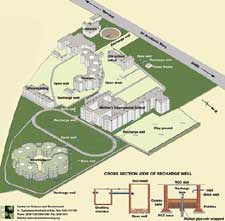 |
The water requirement is met through three tubewells and is supplemented by Municipal water supply.
RAINWATER HARVESTING SYSTEM
In this campus the rainwater from various catchments, including rooftop, surface runoff from open areas, is harvested.
Rooftop rainwater harvesting:
a) Mirambika school
The rooftop rainwater from the northern part of this building is diverted to a dry open well of 18m depth and 2m depth through a network of pipes and collection chambers. The silt from the rooftop rainwater is filtered by using a desilting chamber of 0.6 m x 0.6m x 2.5m depth.
b) Mother's International school
The rooftop rainwater from the northern part of this building is drained to the playground located on the northern part of the building. This roof water, in addition to the surface runoff is harvested by two recharge wells of 1m x 1m x 2m in dimension with a recharge bore of 16m depth. The rooftop rainwater from the southern part of the building is canalised using a network of interconnecting pipes and collection chambers to a recharge well near the existing borewell. The recharge well is 1.5m x 2m x 2.5m in size with a recharge bore of 150mm diametre and 16m depth. A layer of pebble and sand is used to ensure proper filtration.
c) Tapsya building
The rooftop rainwater from this building is collected through a network of pipes and chambers and diverted to the dry open well of 15 m depth and 2m in dia. The rooftop rainwater passes through a desilting chamber before it is diverted to the recharge well.
d) Office block
Rooftop rainwater from the office block is diverted to an abandoned borewell, which was converted to a recharge well by making a pit of 1m x 1m x 2m around it. The recharge well is filled up with pebbles and which acts as filtering media. Filtered water enters the borewell and recharges the subsurface aquifers.
Surface water harvesting:
a) Near Mirambika School
Part of the rooftop rainwater from the Mirambika School and the surface runoff from the unpaved areas are collected in two collection chambers which are provided with perforated slabs. This surface runoff is diverted to a recharge well 1.5 m x 2 m x 2.5m in size with a recharge bore of 150 mm in diametre and of 16m depth. The recharge well is filled with filtering materials to ensure good water quality used for recharge.
b) Playground area
The surface runoff from the playground area is collected in collection chamber constructed at the northwest corner of the playground. This collection chamber was converted to a recharge well by drilling a recharge bore of 150 mm diametre of 18 m depth. The recharge wells are filled with a layer of pebble and sand for filtering the surface runoff, which also improve the quality of water harvested.
c) Power station area
Surface runoff on the eastern side of the Mother's International school building is collected in a open drain and diverted to a recharge well adjacent to the power station near the existing borewell. The recharge well is of 2.5m x 3m x 3m in size with a recharge bore of 20 m depth.
d) Near Ashram building
Rooftop rainwater, along with the runoff from the paved areas surrounding the Ashram building are collected in a recharge well of 2.5m x 1.5m x 2m in size with a recharge bore of 20m depth. The recharge well is filled with a layer of pebble and sand for filtering the surface runoff that improves the quality of water harvested.
The implementation was completed in January 2003 and the water level as on February 2003 was recorded at 27.4m below ground level (bgl).
The cost of the entire rainwater harvesting system was Rs 4.0 lakh.
IMPACT
Water level data
This project showed it was possible to arrest declining water levels through rainwater harvesting. The water level in Ashram was 35.2m below ground level (bgl) in April 2003. Concerned with the plunging water levels in the area, Mother's International School decided to adopt rainwater harvesting in the school and also throughout the entire ashram. The water level recorded in July 2003 was 33.0m (bgl), representing a net rise of 2.2m, or 7.21 feet.
| Water level 2006 | |
| Water level 2005 |
|
| Water level 2003-2004 | |
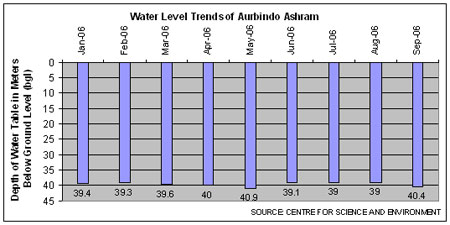 |
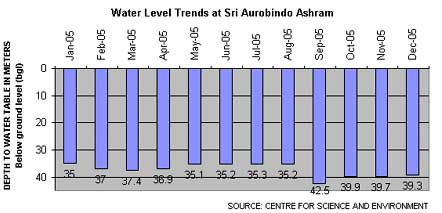 |
| Water Quality 2005 |
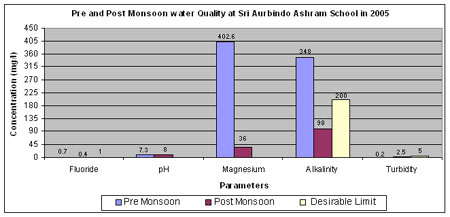 |
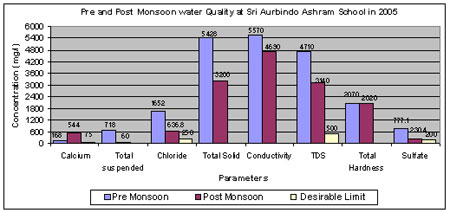 |
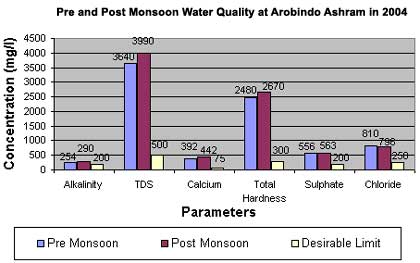 |
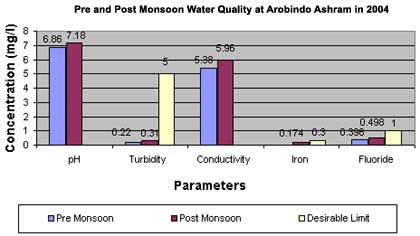 |
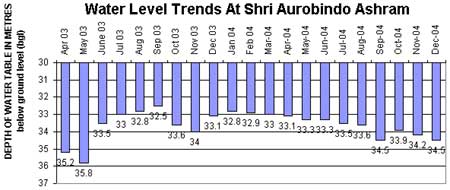 |
For details:
Dr Mehrukh Singh
Principal Mother's International School
Sri Aurobindo Marg,
New Delhi - 110016,
Telephone Nos: (011) 26524817; 26865400
Share this article